|
|
CCMB Seminar Series 2006-2007
______________________________________________________ Events
Center For Computational Molecular Biology Seminar Series
|
Charles DeLisi
Boston University
Computational Identification of
Regulatory Markers for Human Tumors
|
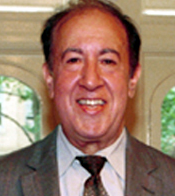
|
Abstract:
I will outline two convergent lines of research in our lab: one a general computational-experimental
strategy for identifying epigenetic alterations in upstream regions which can serve
as markers for incipient neoplastic lesions; the other the development and application
of supervised and unsupervised approaches to identifying the targets of transcriptional
regulators. Results for Wilms' tumor and clear cell renal carcinoma will be briefly
discussed.
Wednesday, May 9th, 2007
4:00 p.m.
CIT Building, Room 241 ~ SWIG Boardroom
|
Mark Gerstein
Gerstein Lab, Yale University
Understanding Protein Function
on a Genome-scale using Networks
|
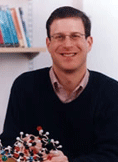
|
Abstract:
My talk will be concerned with topics in proteomics,
in particular predicting protein function on a genomic scale. We approach this through
the prediction and analysis of biological networks -- both of protein-protein interactions
and transcription-factor-target relationships. I will describe how these networks
can be determined through integration of many genomic features and how they can
be analyzed in terms of various simple topological statistics. I will discuss the
accuracy of various reconstructed quantities.
Wednesday, May 2nd, 2007
4:00p.m.
CIT Building, Room 241 ~ SWIG Boardroom
|
Rob Kulathinal
Harvard University
Cambridge, MA
Parallel sequencing, synthetic assembly
and comparative analysis of the
Drosophila mauritiana genome
|

|
Abstract:
New sequencing technologies are beginning to transform the very approaches that
biologists employ. For geneticists interested in speciation or, as Charles Darwin
termed, "that mystery of mysteries", the availability of genomic sequence from closely
related species of sequenced model organisms holds great promise. Using 454 sequencing,
we have generated a 1.5X coverage of the Drosophila mauritiana genome. D. mauritiana
is a sibling species of the genetics workhorse, D. melanogaster, as well as the
more closely related species, D. simulans and D. sechellia. The genomes of these
species were used to both assemble the D. mauritiana genome and to shed light on
its divergence at the molecular level. In addition to the comparative analyses,
a number of challenges will be highlighted, including the short and error-prone
nature of 454 reads relative to Sanger sequencing reads. We hold that such laboratory-scale
genomics provide an emerging entry point to successfully answer outstanding biological
questions.
Wednesday, April 25th, 2007
4:00 p.m.
CIT Building, Room 241 ~ SWIG Boardroom
|
Bruce Hendrickson
Sandia National Laboratory
Albuquerque, New Mexico
High Performance Computing in Biology:
Applications, Algorithms and Architectures
|
|
Abstract:
In its relatively short lifespan, computational biology has had an enormous impact
on high performance computing. The computing requirements of biological applications
have altered the research and business landscape of advanced computing in myriad
ways. In this talk, I will review some of these synergistic developments and speculate
about the even more dramatic changes ahead.
Wednesday, April 18th, 2007
4:00 p.m.
CIT Bldg, Room 241 SWIG Boardroom
|
Wolfgang Peti
Brown University, Providence RI
Folded or Unfolded
|
|
Abstract:
Our research challenges the status quo in protein science, which says that only
proteins with a 3-dimensional structure can fulfill a function. Linus Pauling stated
in 1946 "Answers to many basic problems of biology-nature of growth, mechanism of
duplication of viruses and genes, action of enzymes, mechanism of physiological
activity of drugs, hormones, and vitamins, structure and action of nerve and brain
tissue-may lie in knowledge of molecular structure and intermolecular reactions".
However, in recent years it has been shown that also unstructured or partially structured
proteins also fulfill essential functions. Usually these proteins fold upon binding
to their targeting protein and, in this way, are critical for mediating numerous
regulatory events. My laboratory has identified a large number of these intrinsically
unstructured protein or protein domains which are, significantly, particularly important
in the brain. Our current efforts are focused on identifying and developing methods
that will enable us to determine the 3-dimensional structure of these unstructured
proteins. These structures are very different then usual protein structures, since
they depend on populations of states, rather den defined distances. This, in turn,
will allow us to elucidate the rules that govern their folding upon binding interaction
and advance our understanding of this new paradigm of protein: protein interactions.
Wednesday, April 11th, 2007
4:00 p.m.
CIT Bldg, Room 241 SWIG Boardroom
|
Mayetri Gupta, Ph.D.
University of North Carolina at Chapel Hill
Department of Biostatistics
Faculty Search Candidate
Center for Computational Molecular Biology
Statistical Methods for Deciphering Transcription Regulatory Processes
|
|
Abstract:
Understanding gene regulation within living cells is one of the major scientific
challenges in the post-genome era. Short segments of DNA, known as transcription
factor binding sites (TFBSs) or motifs, are believed to be instrumental in initiating
the process of gene regulation. However, accurate motif discovery, especially in
complex genomes, is a challenging task. New experimental methods studying genome-wide
protein-DNA interactions suggest that certain periodic features of chromatin packaging
are associated with binding of TFs. In this talk, I will present some of our recent
work towards understanding gene regulatory processes, including (1) discovery of
transcription regulatory modules from genomic sequence; (2) assessment of nucleosome
positioning from high density tiling array experiments and (3) relating chromatin
packaging to the presence of TF binding sites and other features of the DNA sequence.
For (1), we introduce a Bayesian hidden Markov model framework for sequences containing
binding site clusters, with a Markovian dependence structure for both motif ordering
and motif site occurrences. For (2), we develop a generalized hierarchical hidden
Markov model that allows for length-restricted features, as well as variability
in probe behavior. Novel recursion-based Monte Carlo algorithms are devised for
efficient model selection and parameter estimation, and applied with considerable
degrees of success to yeast and mammalian data sets. In addition to the attractiveness
of these models for their ability to capture important characteristics of the underlying
biology, the sampling based inference allows us to assess the stochastic variation
in the parameters of interest instead of providing a single point estimate. I will
conclude with a description of the current and future extensions of this work, towards
the overall goal of utilizing multiple sources of genomic data in elucidating regulatory
pathways.
Lecture: Thursday, March 15th 12:00pm CIT, SWIG Room 241
Chalk Talk: Friday, March 16th 12:00pm CIT, SWIG Room 241
|
Yun S. Song, Ph.D.
University of California, Davis
Department of Computer Science
Faculty Search Candidate
Center for Computational Molecular Biology
Computational and Mathematical
Aspects of Meiotic Recombination
|

|
Abstract:
Meiotic recombination creates a mosaic genome from the two homologous genomes of
an individual. In addition to being a major mechanism that can create new genetic
types in a population, recombination has far-reaching consequences on the genealogy
of chromosomes; as a result of recombination, different regions in a chromosome
can have different evolutionary histories. Estimating the frequency and the location
of historical recombination is relevant to a wide range of practical and theoretical
problems in genomics. In this talk, I will address a couple of statistical problems
related to meiotic recombination and sketch some algorithmic work on reconstructing
parsimonious evolutionary histories with recombination.
Lecture: Tuesday, March 13th 12:00 noon CIT, SWIG Room 241
Chalk Talk: Wednesday, March 14th 12:00 noon CIT, SWIG Room 241
|
Hue Sun Chan, Professor of Biochemistry
Departments of Biochemistry and Medical Genetics & Microbiology,
Faculty of Medicine, University of Toronto
Cooperativity Principles in
Protein Folding, Entropic and Enthalpic Barriers
|
|
Abstract:
Many small single-domain proteins undergo cooperative, switch-like folding/unfolding
transitions with very low populations of intermediate, i.e., partially folded, conformations.
This phenomenon is referred to as cooperative folding. For most natural proteins,
cooperativity is likely an evolved trait to guard against disease-causing aggregation.
>From a biophysical standpoint, cooperativity is a remarkable molecular-recognition
feat that has not yet been achieved by de novo experimental design. Therefore, knowing
the biophysical basis of cooperativity is central to addressing many questions in
protein folding and design and to progress in understanding diseases of misfolding.
However, cooperativity is not readily accounted for by common notions about driving
forces for folding. I will discuss how common protein chain models with pairwise
additive interactions are insufficient to account for the folding cooperativity
of natural proteins, and how models with nonadditive local-nonlocal coupling are
able to rationalize cooperative folding rates that are well correlated with native
topology. The traditional formulation of folding transition states entails a folding
free energy barrier with both enthalpic and entropic components. I will explore
the microscopic origins of these thermodynamic signatures in terms of conformational
entropy as well as desolvation (dewetting) effects. Intriguingly, the existence
of significant enthalpic folding barriers raises fundamental questions about the
validity of the funnel picture of protein folding, because such enthalpic barriers
appear to imply that there are substantial uphill moves along a folding trajectory.
Using results from extensive atomic simulations, I will show how the paradox can
be resolved by a dramatic entropy-enthalpy compensation at the rate-limiting step
of folding. In this perspective, the height of the enthalpic barrier is seen as
related to the degree of cooperativity of the folding process.
Wednesday, March 7th, 2007
4:00 p.m.
CIT Building, Room 241 ~ SWIG Boardroom
|
Jennifer Knies
University of North Carolina
Thermal adaptation in the bacteriophage G4
|

|
Abstract:
The likelihood and consequences of adaptation to novel environments can be predicted
if there are common patterns of adaptation to novel environments. Thermal adaptation
is a useful model for studying these common patterns, because the proximate mechanisms
(e.g. biochemical rate processes) that determine the effects of temperature on growth
or performance and the evolutionary causes of thermal adaptation are known. Two
specific hypotheses about thermal adaptation are: (1) Thermal constraints on reaction
rates will cause cold-adapted species to have lower maximal growth rates than hotter-
adapted species at their thermal optima (i.e. "Hotter is better"), and (2) Adaptation
to a novel temperature will result in trade-offs in performance at different temperatures
(i.e. "Trade-off" Hypothesis). Both of these pstem from the idea that there are
functional constraints on biochemical reactions that limit or reduce an organism
perfat different temperatures. These predictions were investigated busing the bacteriophage
G4 as a model experimental system. The growth rate of natural and lab isolates of
G4 was examined ovewide temperature range and evidence was found for both "hotter
isbetter" and the "trade-off" hypotheses. In addition, the proximmechanismderlying
these observed patterns are also being investigated. Higher temperatures are predicted
to select for increased protein stability. This hypothesis is being tested by adapting
multiple phage populations to temperatures above and below their thermal optima,
identifying the genetic bases of adaptation of these populations, and then assaying
the thermostability of the evolved genotypes.
Wednesday, February 28, 2007 4:00 p.m.
CIT Building, Room 241 ~ SWIG Boardroom
|
Eran Halperin, Ph.D.
International Computer Science Institute, Berkeley, California
Faculty Search Candidate
Center for Computational Molecular Biology
Whole-Genome Disease Association Studies:
Challenges and Solutions
|
|
Abstract:
The recent data release of the Haplotype Mapping project, and the rapid reduction
in genotyping costs, open new directions and opportunities in the study of complex
diseases via the analysis of single nucleotide polymorphisms (SNPs) data. At the
same time, the increased size of the SNP datasets set new computational and statistical
challenges.
In this talk I will discuss some of the challenges set by the large-scale
of these studies, and the current solutions to these challenges. In particular,
I will describe recent results on whole-genome haplotype analysis, including haplotype
inference, and the incorporation of the HapMap data in haplotype analysis of case-control
studies. I will also discuss potential drawbacks of these methods due to population
substructure, and suggest solutions that are scalable to the coming large-scale
studies.
Lecture: Monday, February 26th 4:00p.m. CIT, SWIG Room 241
Chalk Talk: Tuesday, February 27th 12:00 noon CIT, SWIG Room 241
|
Andrew Kern, Ph.D.
University of California, Santa Cruz
Center for Biomolecular Science and Engineering
Faculty Search Candidate
Center for Computational Molecular Biology
Human Ultraconserved Elements are Ultraselected
|
|
Abstract:
Ultraconserved elements in the human genome, which have remained nearly un-changed
since our divergence with chicken nearly 310 million years ago, remain an evolutionary
mystery. Two competing explanatory hypotheses are strong selection to maintain their
largely unknown functions, or mutational cold-spots. Using human population re-sequencing
data of 332 such elements and their flanking sequences in 96 individuals, and a
hierarchical Bayesian Markov Chain Monte Carlo (MCMC) analy-sis of the segregating
site frequency spectrum, we find that extremely strong selection within ultraconserved
elements continues in the current human population. Indeed, the strength of selection
acting on ultraconserved elements approximately four times greater than that which
constrains nonsynonymous protein coding bases.
Lecture: Tuesday, February 20th 12:00 noon CIT, SWIG Room 241
Chalk Talk: Wednesday, February 21st 12:00 noon CIT, SWIG Room 241
|
Christina Leslie, Ph.D.
Center for Computational Learning Systems, Columbia University
Faculty Search Candidate
Center for Computational Molecular Biology
Learning predictive models of gene regulation
|
|
Abstract:
Studying the behavior of gene regulatory networks by learning from high-throughput
genomic data has become one of the central problems in computational systems biology.
Most work in this area has focused on learning structure from data -- e.g. finding
clusters or modules of potentially co-regulated genes, or building a graph of putative
regulatory "edges" between genes -- and has been successful at generating qualitative
hypotheses about regulatory networks.
Instead of adopting the structure learning
viewpoint, our focus is to build predictive models of gene regulation that allow
us both to make accurate quantitative predictions on new or held-out experiments
(test data) and to capture mechanistic information about transcriptional regulation.
Our algorithm, called MEDUSA, integrates promoter sequence, mRNA expression, and
transcription factor occupancy data to learn gene regulatory programs that predict
the differential expression of target genes. Instead of using clustering or correlation
of expression profiles to infer regulatory relationships, the algorithm learns to
predict up/down expression of target genes by identifying condition-specific regulators
and discovering regulatory motifs that may mediate their regulation of targets.
We use boosting, a technique from statistical learning, to help avoid overfitting
as the algorithm searches through the high dimensional space of potential regulators
and sequence motifs. We will report computational results on the yeast environmental
stress response, where MEDUSA achieves high prediction accuracy on held-out experiments
and retrieves key stress-related transcriptional regulators, signal transducers,
and transcription factor binding sites. We will also describe recent results on
the hypoxic response in yeast, where we used MEDUSA to propose the first global
model of the oxygen sensing and regulatory network, including new putative context-specific
regulators. Through our experimental collaborator on this project, the Zhang Lab
at Columbia University, we are in the process of validating our computational predictions
with wet lab experiments, with encouraging preliminary results.
Lecture: Thursday, February 22nd 12:00 noon CIT, SWIG Room 241
Chalk Talk: Friday, February 23rd 12:00 noon CIT, SWIG Room 241
|
Niko Beerenwinkel, Ph.D
Harvard University, Program for Evolutionary Dynamics
Faculty Search Candidate, CCMB
Evolutionary Escape on Fitness Landscapes
|

|
Abstract:
The evolution of HIV within individual patients is associated with disease progression
and failure of antiretroviral drug therapy. Using graphical models we describe the
development of HIV drug resistance mutations and show how these models improve predictions
of the clinical outcome of combination therapy. We present combinatorial algorithms
for computing the risk of escape of an evolving population on a given fitness landscape.
The geometry of fitness landscapes and the underlying gene interactions are analyzed
in an attempt to generalize the notion of pairwise epistasis to higher-order genetic
systems. Finally, we discuss the new and exciting prospects for analyzing viral
genetic variation that arises from recent pyro-sequencing technology.
Lecture: Thursday, February 1st, 4:00 pm, CIT SWIG Room 241
Chalk Talk: Friday, February 2nd, 12:00pm, CIT SWIG Room 241
|
John Moult
Center for Advanced Research in Biotechnology
University of Maryland Biotechnology Institute
SNPs, Protein Structure, and Disease
|

|
Abstract:
How does genetic variation influence disease susceptibility? To partly address this
question we have developed structure and sequence based models of the impact of
SNPs on protein function in vivo. The models have been applied to a set of single
nucleotide variants known to cause monogenic disease, and to a set found in the
Human population, not known to be associated with disease. There are two surprising
findings: First, most monogenic disease causing variants act by mildly destabilizing
protein structure. The results imply that most proteins are only just sufficiently
stable to operate effectively in vivo, and suggest a possible general strategy for
developing therapeutics. Second, about a quarter of the population SNPs appear to
seriously impair function at the molecular level. Examination of a set of these
cases suggests a variety of mechanisms that make the larger scale system robust
with respect to component defects. Network level robustness analysis has the potential
to identify those SNPs that most likely contribute to susceptibility to complex
diseases. To facility this, we have integrated all the pertinent data into a 'knowledgenet'
interface (www.snps3d.org), allowing rapid assessment of the known relationships
between proteins relevant to a particular disease, as well as access to molecule
level information and to the supporting literature.
January 31st, 2007
4:00 p.m.
CIT Building, Room 241 ~ SWIG Boardroom
Refreshments will be served at 3:45pm
|
John Quackenbush
Dana-Farber Cancer Institute and
the Harvard School of Public Health
Extracting Biological Meaning from
High-Dimensional Datasets
|

|
Abstract:
The revolution of genomics has come not from the "completed" genome sequences of
human, mouse, rat, and other species. Nor has it come from the preliminary catalogues
of genes that have been produced in these species. Rather, the genomic revolution
has been in the creation of technologies - transcriptomics, proteomics, metabolomics
- that allow us to rapidly assemble data on large numbers of samples that provide
information on the state of tens of thousands of biological entities. Although the
gene-by-gene hypothesis testing approach remains the standard for dissecting biological
function, 'omic technologies have become a standard laboratory tool for generating
new, testable hypotheses. The challenge is now no longer generating the data, but
rather in analyzing and interpreting it. Although new statistical and data mining
techniques are being developed, they continue to wrestle with the problem of having
far fewer samples than necessary to constrain the analysis. One way to deal with
this problem is to use the existing body of biological data, including genotype,
phenotype, the genome, its annotation and the vast body of biological literature.
Through examples, we will demonstrate show how diverse datasets can be used in conjunction
with computational tools to constrain 'omics datasets and extract meaningful results
that reveal new features of the underlying biology.
Wednesday, January 24th, 2007
4:00 p.m.
CIT Bldg, Room 241 SWIG Boardroom
|
Paola Oliveri, Ph.D.
California Institute of Technology
The genomic control of embryo development
|

|
Abstract:
The development from a single fertilized cell to a complex organism is an inherited
property and is entirely encoded in the genome. The developmental program is controlled
by large gene regulatory networks (GRNs). The sea urchin endomesoderm gene regulatory
network is one of the most comprehensively understood regulatory apparatus for control
of spatial and temporal gene expression in any complex developmental system. At
present, more than 50 genes have been linked into this GRN. The architecture of
the network is emerging from a system-level approach, in which computational analysis
is applied to high resolution spatial and temporal gene expression data and large-scale
quantitative perturbation data obtained by gene expression knockouts and other methods,
combined with experimental embryology. In the endomesoderm domain the primary mesenchyme
cell (PMC) GRN is so far the most complete model for early cell specification in
that it extends convincingly from maternal inputs to cell-type differentiation.
We are using the data emerging from the recently sequenced Strongylocentrotus purpuratus
genome together with the transcriptome data and the spatio-temporal profiles of
the sea urchin regulatory genes to address the question of completeness of the endomesoderm
GRN. We identified all gene encoding transcription factors relevant for this embryological
domain, determined their spatio-temporal profile, and we are in the process of integrating
them into the GRN by perturbation and cis-regulatory analysis. The predictive model
constructed from such perturbation data specifies the key cis-regulatory inputs
into regulatory genes and their key outputs terminating at other regulatory genes.
Hence, it is directly testable at the cis-regulatory level. We identified by computational
and experimental methods, and isolated, some central cis-regulatory nodes of the
GRN. In gene transfer experiments these genomic fragments displayed the same responses
to the appropriate perturbations as do the endogenous genes in the whole embryo;
and when the genomic target sites for the relevant inputs were mutated, the cis-regulatory
constructs behave in the expected ways. To date, this system wide authentication
indicates that the perturbation analysis provides the encoded linkages with surprising
accuracy. A predictive model of the GRN provides the essential "transformation function"
between the static genomic regulatory code that is hardwired into the DNA sequence,
and the dynamic events of spatial and temporal gene expression. In addition, by
comparison analysis we show that GRNs are modular in structure and we have identified
some subcircuit design principles or network architectural subcomponents that qualitatively
operate specific regulatory logic function regardless to the specific regulatory
genes that take part.
Wednesday, December 13th, 2006
4:00pm
CIT Bldg ~ Swig Boardroom # 241
|
Liliana Florea
George Washington University
Spaced Seeds for Cross-Species cDNA-to-Genome Alignment
|
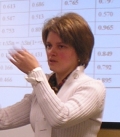
|
Wednesday, December 9th, 2006
CIT Bldg ~ Swig Boardroom # 241
|
Nathan Edwards
University of Maryland
Novel Peptide Identification Using Expressed Sequence Tags and Sequence Database Compression
|
|
Wednesday, December 9th, 2006
CIT Bldg ~ Swig Boardroom # 241
|
Bjarni Halldorson
deCODE Genetics
Tools for association and pedigree analysis
|

|
Wednesday, December 9th, 2006
CIT Bldg ~ Swig Boardroom # 241
|
Dan Fasulo
Siemens Corporation
Personalized Healthcare:
Integrating '-omics' into Clinical Medicine
|
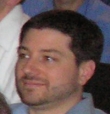
|
Wednesday, December 9th, 2006
CIT Bldg ~ Swig Boardroom # 241
|
Ross Lippert
D.E. Shaw Research
BBBWT: A Memory Efficient Large String Index
|

|
Wednesday, December 9th, 2006
CIT Bldg ~ Swig Boardroom # 241
|
Russell Schwartz
Carnegie Mellon University
Near-Perfect Phylogenetics and the Human Genome
|
|
Wednesday, December 9th, 2006
CIT Bldg ~ Swig Boardroom # 241
|
Knut Reinert
Freie Universitat Berlin
SeqAn - The Software Library for Sequence Analysis
|
|
Wednesday, December 9th, 2006
CIT Bldg ~ Swig Boardroom # 241
|
Russell Turner
John Hopkins University
The Celera Genome Browser: A Tool for Visualizing and Annotating Large Eukaryotic Genomes
|
|
Wednesday, December 9th, 2006
CIT Bldg ~ Swig Boardroom # 241
|
Aaron Halpern
J. Craig Venter Institute
Practical Haplotype Assembly
|
|
Wednesday, December 9th, 2006
CIT Bldg ~ Swig Boardroom # 241
|
Sridhar Hannenhalli, Ph.D.
Penn Center for Bioinformatics, University of Pennsylvania
Deciphering Gene Regulatory Networks
by in silico approaches
|

|
Abstract
Biological processes are controlled at various levels in the cell and while these mechanisms are
poorly understood, transcriptional control is widely recognized as an important component and a better
understanding of which will provide an efficient means for the therapeutic intervention in disease processes.
We have been focusing on various computational problems pertaining to transcriptional regulation, namely,
(1) representation and identification of transcription factor binding sites,
(2) PolII promoter prediction,
(3) Predicting interaction among transcription factors,
(4) Transcriptional modeling, i.e. identifying arrangements of TFs
that co-regulate a set of transcripts.
I will present a brief overview of the computational approaches and challenges as well as applications to
transcriptional regulation in memory storage and heart failure.
Bio
Dr. Hannenhalli received his PhD in 1996 in Computer Sc. from the Penn St. University under Dr. Pavel Pevzner.
After a postdoctoral fellowship at the University of Southern California, he spent 6 years in the industry,
first at Glaxo Smithkline and then at the Celera Genomics. He joined Dept of Genetics in the school of medicine
at UPenn where is currently an Asst. Professor of Bioinformatics.
November 29th, 2006
Wednesday, 4:00 pm
CIT Building ~ SWIG Boardroom # 241
|
Trey Ideker
University of California San Diego
Protein Network Comparative Genomics
|
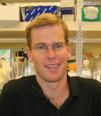
|
Abstract
With the appearance of large networks of protein-protein and protein-DNA interactions
as a new type of biological measurement, methods are needed for constructing cellular
pathway models using interaction data as the central framework. The key idea is
that, by comparing the molecular interaction network with other biological data
sets, it will be possible to organize the network into modules representing the
repertoire of distinct functional processes in the cell. Three distinct types of
network comparisons will be discussed, including those to identify:
- Protein interaction networks that are conserved across species
- Networks in control of gene expression changes
- Networks correlating with systematic phenotypes and synthetic lethals
Using these computational modeling and query tools, we are constructing network
models to explain the physiological response of yeast to DNA damaging agents.
Relevant articles and links:
- Yeang, C.H., Mak, H.C., McCuine, S., Workman, C., Jaakkola, T., and Ideker, T. Validation
and refinement of gene regulatory pathways on a network of physical interactions.
Genome Biology 6(7): R62 (2005).
- Kelley, R. and Ideker, T. Systematic interpretation of genetic interactions using
protein networks. Nature Biotechnology 23(5):561-566 (2005).
- Sharan, R., Suthram, S., Kelley, R. M., Kuhn, T., McCuine, S., Uetz, P., Sittler,
T., Karp, R. M., and Ideker, T. Conserved patterns of protein interaction in multiple
species. Proc Natl Acad Sci U S A. 8:102(6): 1974-79 (2005).
- Suthram, S., Sittler, T., and Ideker, T. The Plasmodium network diverges from those
of other species. Nature 437: (November 3, 2005).
- http://www.pathblast.org
- http://www.cytoscape.org
Acknowledgements: we gratefully acknowledge funding through NIH/NIGMS
grant GM070743-01; NSF grant CCF-0425926; Unilever, PLC, and the Packard Foundation.
November 8th, 2006
Wednesday, 4:00 pm
CIT Building ~ SWIG Boardroom # 241
|
Fumei Lam
Carnegie Mellon University, Pittsburgh PA
Parametric Sequence Alignment and Analysis
|
|
Abstract
Sequence alignment is a fundamental problem in computational biology, serving as
the main component of many algorithms for protein structure and function prediction,
phylogeny inference, and other tasks in sequence analysis.
Varying the objective function parameters of an alignment algorithm can greatly
influence the quality of the resulting alignment. The goal of parametric sequence
alignment is to study the parameter space decomposition and the optimality regions
for all biologically meaningful settings of the parameters. Bounding the number
of regions in the resulting space is an important problem because it indicates the
complexity of finding all optimal alignments of biological or statistical interest.
In this talk, we will survey algorithmic and combinatorial problems arising from
parametric sequence alignment and discuss special cases for which we can obtain
tight bounds on the number of optimality regions.
November 1st, 2006
Wednesday, 4:00 pm
CIT Building ~ SWIG Boardroom # 241
Jacques Cohen
Brandeis University, Waltham, MA, USA
Towards a comprehensive view of computational approaches
in systems biology
Abstract
In the past few years the number of available papers describing computational approaches
in systems biology has increased significantly. These approaches vary considerably
from one another. In this talk we aim to provide a bird’s eye view of the various
methods that have been proposed to analyze and infer gene regulatory networks. In
so doing we are bound to find novel combined approaches that are worth pursuing.
A rough initial classification of the current methods distinguishes between discrete
and continuous, macro (genetic networks) and micro (metabolic pathways), analysis
(forward) and inference (reverse engineering), stochastic (probabilistic) and non-stochastic.
Starting from discrete methods of analysis (e.g., Thomas, Thieffry, de Jong) we
proceed to cover existing reverse engineering approaches (e.g., Akutsu, Somogyi)
including those based on perturbation (e.g., Karp, Collins). At the micro level
we explore recent work done in studying the consistency of biochemical reactions
(e.g., Fages, P. Karp).
One of the findings based on this comprehensive view is that it is worth considering
model-checkers as filters for networks being tested as possible candidates in the
reverse engineering process. We conclude by raising a few questions about research
directions in systems biology that are worth exploring.
(Work done jointly with Sam Blasiak)
October 11th, 2006
Wednesday, 4:00 pm
CIT Building SWIG Boardroom #241
_______________________________________________________ Events
|















